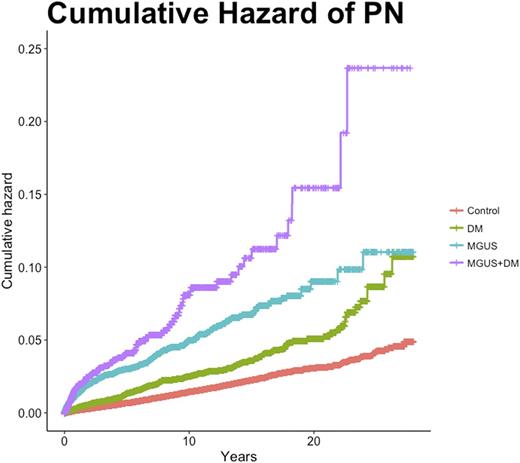Abstract
Introduction
Monoclonal gammopathy of undetermined significance (MGUS) is the precursor state of multiple myeloma (MM) and related disorders with a prevalence of 4.2%. Peripheral neuropathy (PN) is a reported complication of MGUS and 20% of newly diagnosed MM patients present with PN. These MM patients are more likely to develop more severe PN during treatment with certain drugs used to treat MM (e.g. bortezomib and thalidomide). Previous studies have been inconsistent regarding the rate of PN in the MGUS population with estimates ranging from 3-70%. A rate of 15-20% is however the most widely cited. Studies have also been inconsistent regarding the implications of PN for progression of MGUS to MM and related disorders and even whether MGUS confers any increased risk of PN at all.
These inconsistencies can mostly be attributed to the small sample sizes and retrospective nature of previous studies, the lack of standardized methods for PN diagnosis in this patient group, and the high rate of undiagnosed PN in the general population.
PN has been reported to be relatively common in this patient group, and can be debilitating, significantly reducing quality of life and raising health-care costs for MGUS and MM patients. Therefore, we were motivated to conduct a large population-based study with the primary objective assessing the recognition and risk of PN. To avoid the potential surveillance bias associated with a diagnosis of MGUS we also performed a comparison with patients with diabetes mellitus (DM), a population routinely examined for PN because of their well-recognized and high risk of PN. Additionally, as a secondary objective, we assessed the potential effect of PN on the rate of progression of MGUS to MM and related disorders.
Methods
Subjects diagnosed with MGUS in the years 1986 to 2013 were obtained from a registry of a network of Swedish hematology/oncology centers and from the Swedish Patient Registry. Four controls were matched to each case through the Swedish Population Registry by sex, year of birth, and county of residence. Diagnoses of PN and DM were acquired from the Swedish Patient Registry. Data on the date of death was acquired from the Swedish Cause of Death Registry. Information on MGUS progression was obtained from the Swedish Cancer Registry
Exposure was having MGUS, DM, or MGUS and DM. Having DM was defined as a diagnosis of DM at any time. The outcome was the occurrence of PN while censoring at progression to MM and related disorders. Cox proportional hazard regression was performed adjusting for age, sex, and year of MGUS diagnosis. For this analysis, participants with previous PN or censoring event before the date of MGUS diagnosis were excluded.
Additionally we performed analysis of the rate of progression of MGUS with and without PN to MM and related disorders. For this analysis we used a multi-state Cox proportional hazard regression model adjusting for age, sex, and the year of MGUS diagnosis.
Results
A total of 18,668 subjects with MGUS were identified and 97,641 matched controls enrolled, a total of 2,685 individuals were excluded. A total 13,899 of subjects had DM of whom 2,438 also had MGUS. All exposed groups had a higher rate of PN than controls (controls: 1.2%, MGUS: 2.8%, DM: 2.3%, MGUS+DM: 4.8%) as well as a significantly increased hazard of PN as compared to controls (MGUS: hazard ratio (HR)=4.0; 95% confidence interval (CI) 3.6-4.4, DM: HR=1.8; 95% CI 1.6-2.1, MGUS+DM: HR=6.0; 95% CI 5.0-7.3). Progression to MM or related disorder was not different in MGUS individuals with PN (HR=0.85; 95% CI 0.68-1.07). The proportion of the total MGUS cohort that progressed was 12.4% and 15.5% for individuals with MGUS with and without PN, respectively.
Discussion
In this large population-based real-world cohort study on more than 18,000 MGUS individuals and their almost 100,000 matched controls, we found that individuals with MGUS are at a 4-fold risk of PN when compared to controls. Interestingly, we found that MGUS individuals are at a higher risk of PN than patients with DM, a population routinely screened for PN because of its well-recognized risk of PN. Additionally, the rates of PN diagnosis in this real-world patient care setting are far below the rate of PN most widely reported in non-registry based studies. This suggests serious under-recognition of this important complication in the real world care of individuals with MGUS.
No relevant conflicts of interest to declare.
Author notes
Asterisk with author names denotes non-ASH members.


This feature is available to Subscribers Only
Sign In or Create an Account Close Modal